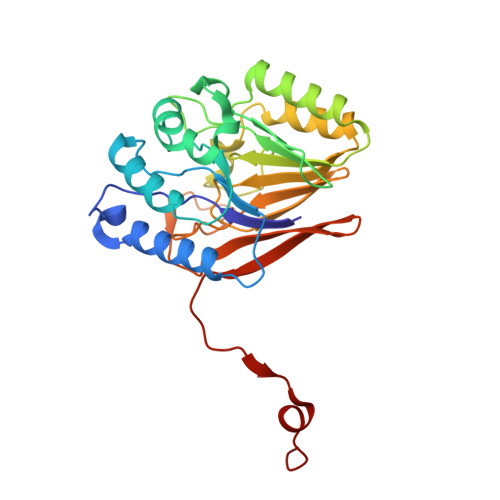Substrate-promoted formation of a catalytically competent binuclear center and regulation of reactivity in a glycerophosphodiesterase from Enterobacter aerogenes.
Hadler, K.S., Tanifum, E.A., Yip, S.H., Mitic, N., Guddat, L.W., Jackson, C.J., Gahan, L.R., Nguyen, K., Carr, P.D., Ollis, D.L., Hengge, A.C., Larrabee, J.A., Schenk, G.(2008) J Am Chem Soc 130: 14129-14138
- PubMed: 18831553
- DOI: https://doi.org/10.1021/ja803346w
- Primary Citation of Related Structures:
3D03 - PubMed Abstract:
The glycerophosphodiesterase (GpdQ) from Enterobacter aerogenes is a promiscuous binuclear metallohydrolase that catalyzes the hydrolysis of mono-, di-, and triester substrates, including some organophosphate pesticides and products of the degradation of nerve agents. GpdQ has attracted recent attention as a promising enzymatic bioremediator. Here, we have investigated the catalytic mechanism of this versatile enzyme using a range of techniques. An improved crystal structure (1.9 A resolution) illustrates the presence of (i) an extended hydrogen bond network in the active site, and (ii) two possible nucleophiles, i.e., water/hydroxide ligands, coordinated to one or both metal ions. While it is at present not possible to unambiguously distinguish between these two possibilities, a reaction mechanism is proposed whereby the terminally bound H2O/OH(-) acts as the nucleophile, activated via hydrogen bonding by the bridging water molecule. Furthermore, the presence of substrate promotes the formation of a catalytically competent binuclear center by significantly enhancing the binding affinity of one of the metal ions in the active site. Asn80 appears to display coordination flexibility that may modulate enzyme activity. Kinetic data suggest that the rate-limiting step occurs after hydrolysis, i.e., the release of the phosphate moiety and the concomitant dissociation of one of the metal ions and/or associated conformational changes. Thus, it is proposed that GpdQ employs an intricate regulatory mechanism for catalysis, where coordination flexibility in one of the two metal binding sites is essential for optimal activity.
Organizational Affiliation:
School of Molecular and Microbial Sciences, The University of Queensland, St Lucia, Queensland 4072, Australia.






















